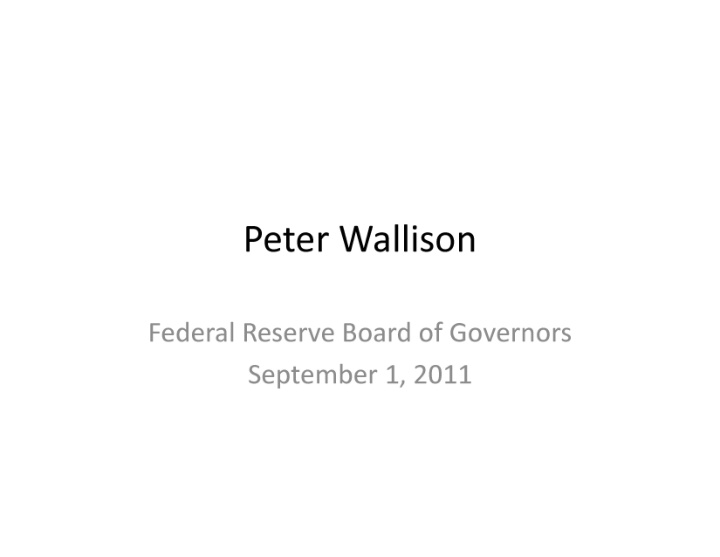



Peter Wallison Federal Reserve Board of Governors September 1, 2011
A History of Home Values The Yale economist Robert J Shiiier created an index of American housing prices going back to 1890. It is based on sale prices of standard existing houses, not new construction, to track the value of housing as an investment over time. It presents housing values in consistent terms over 116 years, factoring out the effects of inflation The 1890 benchmark is 100 on the chart. If a standard house sold in 1890 for $100,000 (inflation- adjusted to today's dollars), an equivalent standard house would have sold for $66,000 in 1920 (66 on the index scale) and $199,000 m 2006 (199 on the index scale, or 99 percent higher than 1890). This slide contains a graph that charts the home price index on the Y-axis and time, from 1890 to 2006, on the X-axis. The slide contains explanatory text and highlights six specific time periods. Title: A History of Home Source "Irrational Exuberance," 2nd Edition 2006 OyRobetrJ Shiller Bill Marsh/ The New York Times Values. Text: The Yale economist Robert J. Shiller created an index of American housing prices going back to 1890. IT is based on sale prices of standard existing houses., not new construction, to track the value of housing as an investment over time. It presents housing values in consistent terms over 116 years, factoring out the effects of inflation. The 1890 benchmark is 100 on the chart. If a standard house sold for $100,000 (inflation-adjusted to today’s dollars), an equivalent standard house would have sold for $66,000 in 1920 (66 on the index scale) and $199,000 in 2006 (199 on the index scale, or 99 percent higher than 1890). The chart notes a period of “decline and run up in the first half of the 20th century. The chart has text that notes that “prices 76 in 1918. The price index remained in the 70 to 80 1922 through 1945. During the Great Depression, the index trended slightly upward from around 72 in 1929 to around 81 in 1941. During the World War II period from 1941 to downward to about 66 in 1921. During the World War I period, the price index fell from around 97 in 1914 to about hovered around 110 for the next 50 years from 1947 to 1997. However there were two spikes during the boom period of the 1970s (from 1976 to 1979) and the 1980s (from 1984 to 1989) when the index spiked at levels just above 120. After returning to the 110 level in 1997, the price index soared precipitously over the next 9 years rising to 199 in 2006. The chart calls with 1997 to 1006 period the “Current Boom.” The text on the chart notes these “Boom Times.” It states “[T]wo gains in recent decades were followed by returns to levels consistent since the late 1950s. Since 1997, the index has risen about 83 percent.” housing demand.” After starting at 100 in 1890, the index rises to around 124 in 1894 and then proceeds to trend dropped as mass production techniques appeared early in the 20th century. Prices spiked with post-[World] War [II] 1945, the index hit a low of around 69 in 1942 rising to around 87 in 1945 (on its way to 110 in 1947. The index
The U.S. Housing Bubble: Case-Shiller National Home Price Index Values 1987Qlto2011Ql This slide contains a graph of the Case-Shiller National Home Price Index. The graph shows the home price index starting off at just over 60 in the first quarter of 197 and rising slowly to 100.00 in the first quarter of 2000. The index begins to rise more rapidly peaking at 189.93 in the second quarter of 2006. The index then drops quickly to a value of just over 130 in the first quarter on 2009 before settling at 125.41 in the first quarter of 2011.
Quarterly Residential ABS. MBS & CDO Volume This slide contains a graph that charts, over time, the number of issues and the volume in millions of dollars of quarterly residential ABS, MBS, and CDO issuances combined. The time period is the first quarter of 2003 through the fourth quarter of 2008. The number of issuances rises from about 500 in the first quarter of 2003 to between 800 and i Proceeds (US$m) ^ — » of issues 900 during the period from the second quarter of 2005 through the first quarter of 2007. There is then a steep decline nearly $600 billion in the second quarter of 2007 before collapsing to around $10 billion in the fourth quarter of 2008. with the number of issuances in the fourth quarter of 2008 falling to fewer than 25. The dollar value of issuances follows a similar pattern rising from between $300 billion and $400 billion in the first three quarters of 2003 to
Recommend
More recommend